GFRP rock bolts are an innovative and efficient solution for rock stabilization. However, their effectiveness depends on proper installation. This article will provide a detailed guide on how to ensure proper installation of GFRP rock bolts.
What are GFRP rock bolts?
GFRP rock bolts, or glass fiber-reinforced polymer rock bolts, are a type of rock reinforcement. They are made of a composite material that combines the strength of fiberglass with the durability of polymer. This makes them an ideal solution for stabilizing rock formations in various applications.
GFRP rock bolts are lightweight, corrosion-resistant, and have high tensile strength. They are also non-metallic, which makes them suitable for use in environments where metal corrosion is a concern. These properties make GFRP rock bolts a popular choice for use in mining, tunneling, and civil engineering projects.
Advantages of using GFRP rock bolts
GFRP rock bolts offer several advantages over traditional steel rock bolts. These advantages include:
Corrosion resistance
GFRP rock bolts are resistant to corrosion, which makes them ideal for use in corrosive environments. This property ensures that the rock bolts will remain intact and effective for a longer period, reducing the need for frequent replacements.
Lightweight
GFRP rock bolts are much lighter than steel rock bolts, making them easier to handle and install. This property reduces the risk of injury and increases the efficiency of the installation process.
High tensile strength
Despite their lightweight nature, GFRP rock bolts have high tensile strength. This property ensures that they can withstand the forces exerted on them during installation and in service, providing reliable rock stabilization.
Non-metallic
GFRP rock bolts are non-metallic, which makes them suitable for use in environments where metal corrosion is a concern. This property ensures that the rock bolts will not corrode and become ineffective over time.
Factors affecting the installation of GFRP rock bolts
Several factors can affect the installation of GFRP rock bolts. These factors include:
Rock quality
The quality of the rock formation is a critical factor that affects the installation of GFRP rock bolts. In rock formations with poor quality, such as fractured or weak rock, the installation of GFRP rock bolts may be challenging. The rock may not provide sufficient support for the rock bolts, leading to ineffective stabilization.
Water presence
The presence of water in the rock formation can also affect the installation of GFRP rock bolts. Water can weaken the adhesive bond between the rock bolt and the rock formation, leading to reduced effectiveness. It is essential to ensure that the rock formation is dry before installing GFRP rock bolts.
Environmental conditions
Environmental conditions, such as temperature and humidity, can also affect the installation of GFRP rock bolts. Extreme temperatures or high humidity can interfere with the curing of the adhesive, leading to weak bonds and reduced effectiveness.
Installation technique
The installation technique used can significantly affect the effectiveness of GFRP rock bolts. Proper installation techniques must be followed to ensure that the rock bolts are installed correctly and provide reliable stabilization.
Steps to ensure proper installation of GFRP rock bolts
Proper installation of GFRP rock bolts is crucial for their effectiveness in stabilizing rock formations. Here are the steps to ensure proper installation:
Preparation of the hole
The first step in the installation of GFRP rock bolts is the preparation of the hole. The hole must be drilled to the correct diameter and depth to ensure a proper fit for the rock bolt. The hole should also be cleaned to remove any debris or loose rock that may interfere with the installation.
Selection of the adhesive
The selection of the adhesive is a critical step in the installation of GFRP rock bolts. The adhesive must be compatible with the rock formation and the rock bolt material. It should also be suitable for the environmental conditions, such as temperature and humidity, in which the installation will be carried out.
Mixing the adhesive
Once the adhesive has been selected, it must be mixed according to the manufacturer’s instructions. Proper mixing is essential to ensure that the adhesive cures correctly and provides a strong bond.
Insertion of the bolt
After mixing the adhesive, the next step is the insertion of the bolt. The adhesive should be applied to the rock bolt, and the bolt should be inserted into the prepared hole. The bolt should be rotated during insertion to ensure that the adhesive is evenly distributed and provides a strong bond.
Curing time
After the bolt has been inserted, it must be allowed to cure for the recommended time. During this period, the adhesive will harden and form a strong bond between the rock bolt and the rock formation. It is essential to avoid disturbing the bolt during the curing period to ensure a proper bond.
Inspection
After the curing period, the installed GFRP rock bolts should be inspected to ensure that they are properly installed and provide reliable stabilization. Any signs of failure or weakness should be addressed immediately to ensure the safety and effectiveness of the rock stabilization.
Conclusion
Proper installation of GFRP rock bolts is crucial for their effectiveness in stabilizing rock formations. By following the steps outlined in this article, you can ensure that GFRP rock bolts are installed correctly and provide reliable rock stabilization.




























